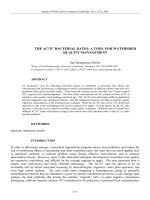the complete wireless communications professional..a guide for engineers and managers
Bạn đang xem bản rút gọn của tài liệu. Xem và tải ngay bản đầy đủ của tài liệu tại đây (1.1 MB, 402 trang )
The Complete Wireless
Communications Professional:
A Guide for Engineers and Managers
The Complete Wireless
Communications Professional:
A Guide for Engineers and Managers
William Webb
Artech House
Boston • London
Library of Congress Cataloging-in-Publication Data
Webb, William, 1967–
The complete wireless communications professional : a guide for engineers
and managers / William Webb
p. cm. — (Artech House mobile communications library)
Includes bibliographical references and index.
ISBN 0-89006-338-9 (alk. paper)
1. Wireless communication systems. 2. Mobile communication systems.
I. Title. II. Series.
TK5103.2.W42 1999
621.6845—dc21 98-51802
CIP
British Library Cataloguing in Publication Data
Webb, William, 1967–
The complete wireless communications professional : a guide for engineers
and managers—(Artech House mobile communications library)
1. Wireless communication systems.
I. Title
621.3’82
ISBN 0-89006-338-9
Cover design by Lynda Fishbourne
© 1999 ARTECH HOUSE, INC.
685 Canton Street
Norwood, MA 02062
All rights reserved. Printed and bound in the United States of America. No part of
this book may be reproduced or utilized in any form or by any means, electronic or
mechanical, including photocopying, recording, or by any information storage and
retrieval system, without permission in writing from the publisher.
All terms mentioned in this book that are known to be trademarks or service
marks have been appropriately capitalized. Artech House cannot attest to the accu-
racy of this information. Use of a term in this book should not be regarded as
affecting the validity of any trademark or service mark.
International Standard Book Number: 0-89006-338-9
Library of Congress Catalog Card Number: 98-51802
10987654321
Contents
Preface What is a complete wireless professional? xiii
Introduction xiii
Format of this book xiv
Acknowledgments xv
Part I Introductory material 1
1 Some interesting history 3
1.1 Introduction 3
1.2 Early history 4
1.3 Some key milestones in mobile radio history 8
1.4 Recent history 10
References 16
Part II Mobile radio systems 17
2 The basics of mobile radio 19
2.1 Introduction 19
v
2.2 Basic principles of propagation 20
2.3 Radio spectrum utilization 32
2.4 Basic system design 37
2.4.1 System overview 37
2.4.2 Voice encoding 37
2.4.3 Secure transmission 46
2.4.4 Overcoming channel imperfections 48
2.4.5 Frequency and phase modulation 55
2.4.6 Clock recovery 64
2.4.7 Carrier recovery 66
2.4.8 Multiple access 68
2.5 Packet and circuit transmission 79
2.6 Theoretical capacity of mobile radio systems 80
References 82
Further reading 83
3 Cellular radio technologies 85
3.1 The range of cellular systems 85
3.2 GSM 88
3.2.1 System architecture 88
3.2.2 Locating a subscriber and starting calls 91
3.2.3 Transmission within GSM 93
3.3 cdmaOne 101
3.4 Other systems 106
References 106
4 Private mobile radio systems 107
4.1 Introduction 107
4.2 Simple private radio systems 114
vi The Complete Wireless Communications Professional
4.3 TETRA 119
4.3.1 Introduction 119
4.3.2 System operation 120
4.3.3 Technical parameters 123
4.4 Other systems 125
References 125
5 Other mobile radio systems 127
5.1 Introduction 127
5.2 Cordless systems 128
5.2.1 Overview of cordless telephony 128
5.2.2 Digital enhanced cordless telephone 130
5.2.3 Personal handiphone system 134
5.3 Wireless local loop systems 135
5.3.1 Introduction to wireless local loop 135
5.3.2 Access technologies: radio and cable 137
5.3.3 WLL and cellular: the differences 142
5.3.4 Technologies for WLL and LMDS/MVDS 144
5.4 Satellite systems for telephony 149
5.4.1 Introduction 149
5.4.2 Concept 150
5.4.3 Economics of satellite systems 153
5.5 TV, radio, and other systems 154
References 159
6 Interfacing with fixed networks 161
6.1 The need for fixed networks 161
6.2 Fixed network architectures 162
6.3 Fixed network protocols 170
Contents
vii
6.4 Fixed mobile convergence 178
6.4.1 Introduction 178
6.4.2 Defining fixed-mobile convergence 179
6.4.3 Possible solutions 179
6.4.4 The future of the FMC marketplace 185
References 187
Part III The mobile network operator 189
7 Designing a mobile radio network 191
7.1 Technical design 191
7.1.1 Introduction 191
7.1.2 Network planning 193
7.1.3 Radio planning 196
7.1.4 Microcells and picocells 198
7.1.5 Interconnection 199
7.1.6 Operations and maintenance planning 203
7.1.7 Supplier selection 204
7.1.8 Network deployment 205
7.2 Applying for a license 205
7.3 The mobile radio equipment manufacturer 208
References 210
8 Economics of a mobile radio network 211
8.1 Understanding financial information 211
8.1.1 Introduction to accounting 211
8.1.2 The profit and loss account 212
8.1.3 The balance sheet 215
8.1.4 The funds flow statement 218
8.1.5 Performing first pass modeling 221
viii The Complete Wireless Communications Professional
8.2 The business case 223
8.2.1 The overall structure of the business case 223
8.2.2 The network costs 223
8.2.3 The operating expenses 227
8.2.4 Revenue 227
8.2.5 Financing 233
8.2.6 Summary 235
References 238
9 Operating a mobile radio network 239
9.1 Introduction 239
9.2 Monitoring the network 240
9.3 Tariff policies and their implications 244
9.4 Capacity enhancement 246
9.4.1 Introduction 246
9.4.2 The available capacity enhancement techniques 246
9.4.3 Dual-band operation 247
9.4.4 Techniques affecting the cluster size 247
9.4.5 Using more cells 251
9.4.6 Which capacity enhancement techniques should be
used when? 252
10 Large users of mobile radio networks 255
10.1 Introduction 255
10.2 Railways 257
10.2.1 Introduction 257
10.2.2 Current railway communications within Europe 258
10.2.3 Railway requirements 259
10.2.4 PMR versus cellular 261
Contents ix
10.3 Police 263
10.3.1 Introduction 263
10.3.2 Description of requirements 264
10.3.3 Selection of radio system 265
10.4 Other emergency services 266
10.5 Other users 267
11 Future mobile radio systems 269
11.1 Progress in radio systems 269
11.2 The third generation vision 270
11.3 Designing the third generation system 274
References 277
Part IV Regulators and governments 279
12 Radio spectrum 281
12.1 Introduction 281
12.2 The management of radio spectrum 282
12.3 Modern allocation and assignment methods 287
12.4 Implications for the mobile radio operator 290
12.5 Government policy 294
References 297
13 Standardization 299
13.1 Introduction 299
13.2 Standards-making bodies 300
13.3 Writing standards 304
References 307
x The Complete Wireless Communications Professional
Part V Becoming a better wireless professional 309
14 Areas of conflict 311
14.1 Introduction 311
14.2 TETRA versus GSM 313
14.2.1 Background to the debate 313
14.2.2 Evaluation of the technologies 313
14.2.3 Economic comparison 315
14.2.4 Analyzing the debate 318
14.3 DECT versus PHS 319
14.3.1 Background to the debate 319
14.3.2 The key issues 319
14.3.3 Analyzing the debate 321
14.4 CDMA versus TDMA 322
14.4.1 Background to the debate 322
14.4.2 The capacity of CDMA versus TDMA 323
14.4.3 Other issues introduced into the debate 325
14.4.4 Analyzing the debate 327
14.5 Handling conflict 327
References 328
15 Management 329
15.1 Introduction 329
15.2 An overview of management 330
15.3 Understanding corporate strategy 332
References 338
16 The complete wireless professional 339
16.1 Introduction 339
Contents
xi
16.2 Conferences and publications 340
16.3 Links with research organizations 346
16.4 Qualifications 349
References 350
Appendix A Erlang B macro 351
Appendix B Mandating standards 353
B.1 Introduction 353
B.2 The key issues 354
B.3 Case studies 359
B.4 Implications 361
B.5 Conclusions 362
References 363
Glossary 365
About the author 385
Index 387
xii The Complete Wireless Communications Professional
Preface
What is a complete wireless
professional?
Since we cannot know all that is to be known of everything, we ought to
know a little about everything.
Blaise Pascal (1623–1662)
Introduction
When thinking about mobile radio engineers there is a tendency to
assume that the engineering function relates solely to the technical
aspects of the network, such as the equipment design or the network
design. That is certainly a key part of the role of a mobile radio engineer.
However, increasingly engineers are required to interact with profession-
als from other divisions. The “complete wireless professional” should
know about mobile networks; fixed networks; other types of mobile
systems; regulatory and government policy; the requirements of the
users; and financial, legal, and marketing issues. Otherwise, there is a
tendency for the engineering, finance, and marketing departments to be
xiii
completely separate entities that are unable to communicate accurately
with each other. The net result is products that do not fit the marketing
requirements or are not financially viable, although they may be master-
pieces of advanced engineering design.
This book looks at the range of topics that complete wireless commu-
nications professionals need to understand in order to perform their task
well. Clearly, above all else, they need to have an engineering knowledge
of how mobile radio systems work. Such a body of knowledge is con-
tained in many excellent text books and reference works; the intention
here is to provide the salient points in each area and a guide to further
reading. In other areas such as finance, the complete wireless professional
only requires an understanding of the key issues, and the brief description
provided in this book may be sufficient.
To some extent, this book gathers reference material from a wide
range of technical, managerial, and financial sources and represents in
summary form those issues that are key to the complete wireless profes-
sional. By encompassing the information in a suitable framework and
providing additional chapters on areas such as the resolution of conflicts
and career structure, it is hoped that the effect of the whole is greater than
the sum of its parts.
Above all, complete wireless professionals need to understand the
world around them and apply this knowledge to engineering issues. This
book describes the world of mobile radio.
Format of this book
This book is divided into five parts.
◗
This first part provides introductory material in the form of a chap-
ter discussing the relevant history of mobile communications.
◗
The second part looks at mobile radio systems, considering the
basics of mobile radio, the design of cellular and private radio sys-
tems, and the issues concerned with interworking with the fixed
network.
◗
The third part looks at the role of a mobile radio operator and dis-
cusses the design of mobile radio networks, the operation of these
xiv The Complete Wireless Communications Professional
networks, the needs of large user groups, and the future of mobile
radio systems.
◗
The fourth part looks at the regulatory and government decisions
that impact mobile radio, including the management of radio spec-
trum, the standardization of mobile radio systems, and the effect of
government policy on the mobile radio community.
◗
The final part focuses on becoming a better engineer by considering
the resolution of conflicts such as the time division/code division multiple
access (TDMA/CDMA) debate, on the need for understanding mana-
gerial issues, and finally on the way to become a complete wireless
professional through professional vehicles and career structure.
Acknowledgments
In writing this book, I drew upon all my experience gained over years in
the industry. I have learned something from almost everyone with whom
I have come into contact and thank all of those with whom I have had dis-
cussions. Special thanks are due to a number of key individuals. During
my time at Multiple Access Communications, Professor Ray Steele, Pro-
fessor Lajos Hanzo, Dr. Ian Wassell, and Dr. John Williams, among others,
taught me much about the workings of mobile radio systems. At Smith
System Engineering, Richard Shenton, Dr. Glyn Carter, and Mike Shan-
non provided valuable knowledge, as have contacts with a number of
others in the industry, including Michel Mouly (Independent Consult-
ant), Dirk Munning (DeTeCon), Michael Roberts (Alcatel), Mike Watkins
and Les Giles (Racal-BRT), Mike Goddard and Jim Norton (Radiocommu-
nications Agency), and Phillipa Marks (NERA). At NetCom Consultants,
Steve Woodhouse, Don Pearce, Mark Cornish, and others taught me
about WLL and cellular operators. While at Motorola, Raghu Rau has
provided invaluable guidance. Many presentations and papers from those
involved in the mobile radio industry contributed to my understanding.
Most importantly, my wife, Alison, has persevered as I worked many eve-
nings and spent much time away from home in my quest to absorb
knowledge in as many spheres as possible, to gain additional qualifica-
tions, and to try to become a complete wireless communications profes-
sional myself.
Preface xv
Introductory
material
I
PART
Some interesting
history
When I want to understand what is happen-
ing today, or to try and decide what will
happen tomorrow, I look back.
Oliver Wendell Holmes, Jr.
1.1 Introduction
The complete wireless professional does not
need to be a historian. One will be able to
design mobile radio networks or products
equally well whether aware or not that the
first demonstration of a radio transmission
was made by Hertz. However, the complete
wireless professional would do well to learn
from some of the lessons of mobile radio over
its history. Because of the dramatic change in
the design and deployment of mobile radio
over the last 100 years and the change in eco-
nomics and uses of radio systems, the most
relevant lessons are those from most recent
times. Hence, this chapter provides a short
summary of the historical background and
3
Contents
1.1 Introduction
1.2 Early history
1.3 Some key
milestones in mobile
radio history
1.4 Recent history
1
CHAPTER
tries to select some of the key lessons that can be learned. An excellent
description of the history of mobile radio development, including a
detailed analysis of the last 15 years of cellular deployment, can be found
in [1],
1
while a very readable biography of the founder of Motorola, Paul
Galvin [2], describes how Motorola shaped much of the development of
mobile radio from 1930 onward. This section provides a short summary of
the topics that the references describe in much greater detail.
The key issues that the complete wireless professional should learn
from this chapter are:
◗
History, particularly recent history, has a number of important les-
sons that do not seem to have been learned by many in the mobile
radio business;
◗
Standardization is far from an assured route to success, with the
global system for mobile communications (GSM) being the only stan-
dardized product among a wide range of standards to have been
highly successful;
◗ Standardization of GSM took 13 years in total;
◗ New radio systems such as cdmaOne can emerge from unexpected
sources and, with the right political and economic backing, can
become important globally.
1.2 Early history
Some of the key historical developments leading to today’s mobile radio
systems are shown in Figure 1.1.
The first radio transmissions are attributed to Heinrich Hertz in 1885.
The first radio system was very simple, using a switch and an induction
coil to generate a spark across two electrodes. The receiver was a loop
made from copper wire around 35 cm in diameter, with a small gap in the
loop. When the “transmitter” generated a spark, a small spark was seen to
jump the gap in the receiving coil. Spark transmission was used as the
basis for most radio equipment until around 1915 and is the reason why
radio operators are sometimes known as “sparks.” Hertz’s work aroused
4 The Complete Wireless Communications Professional
1. This is a superbly written and highly authoritative book and comes highly recommended.
much scientific interest, but it took the emergence of a scientist with busi-
ness acumen to move these discoveries into the commercial domain.
Some interesting history 5
1880
1890
1900
1910
1920
1930
1940
1950
1960
1970
1980
1990
Technical milestones Applications
Theoretical prediction of radio waves
Generation of radio waves (Hertz)
Tuned circuit (Lodge)
Aerial/earth system (Marconi)
Speech transmission (Fessenden)
Thermionic valve (Fleming)
Valve transmitter (Meissen)
First international spectrum
conference
Frequency modulation (Armstrong)
Cellular concept (Bell Labs)
Junction transistor (Schockley)
Digital integrated circuits
Solid state switches
Microprocessor
Cross-channel tests (UK)
Royal Navy (UK)
Transmission to automobile (US)
Merchant shipping (UK)
Transatlantic telegraph service
Radio direction finding (UK)
Aircraft use for artillery spotting (UK)
Transportables (UK)
Police use (Detroit, US)
Fishing boats (Norway, UK)
Aviation navigation and control
Telephones on ocean liners (UK)
Private mobile radio systems (US)
Operator controller mobile phones (US)
Automatic mobile telephones
Cellular test (US)
Cellular services (Japan)
Digital cellular networks (Europe)
Iridium satellite services launched
Figure 1.1 Key historical milestones.
Perhaps the father of today’s mobile radio systems was Guglielmo
Marconi, born in Italy in 1874. Marconi was first a scientist who made
the important breakthrough of redesigning the transmitter from a gap
between two electrodes to connecting one electrode to the earth and the
other to a metal pole placed on top of a mast (the aerial of today). By this
method, he was able to demonstrate transmissions over a range of a
few kilometers rather than just across the laboratory. Marconi tried to
approach the Italian Post Office for sponsorship of his work but was
unsuccessful. He then moved to the United Kingdom, where the British
Post Office was prepared to provide sponsorship. This proved to be a
shrewd move because the first application of mobile radio was in shipping
and, at the time, the United Kingdom had the world’s largest shipping
fleet. Marconi’s first sales of radio systems were in 1900 when the Royal
Navy ordered 32 sets at the equivalent of today’s cost of $500,000 per set
with annual royalty payments of $270,000 per set. It was revenue from
deals such as this that enabled Marconi to found a company and develop
new radio products. For some time, the Marconi company was the
world’s largest producer of radio equipment. Marconi was awarded the
Nobel Prize for Physics in 1907 and died in 1937. The company he
founded is now part of the General Electric Corporation (GEC).
Other important developments included the invention of the thermi-
onic diode in 1904, which lead to practical high-vacuum triodes by 1912,
facilitating the use of narrower band transmissions and making the trans-
mission of speech a possibility. The superheterodyne receiver was devel-
oped by Armstrong and Fessenden in 1912, and by 1933 Armstrong had
developed the concept of frequency modulation.
The First World War proved an important vehicle for demonstrating
the value of mobile radio in military maneuvers, especially for use by
spotter planes providing reports for artillery. The need for smaller and
lighter transmitters for planes hastened the reduction in size of radios to
the extent that they could be carried in a backpack.
After the First World War, the main impetus for developments came
from broadcasting. The rapid increase in the number of radio stations,
especially in the United States, resulted in a commercialization of receiv-
ers. It also resulted in efforts to coordinate the use of radio spectrum, and
the first international spectrum management conference took place in
Washington in 1927. This standardized the use of frequencies up to
1.5 MHz—the highest frequency thought to be of practical use for radio
6 The Complete Wireless Communications Professional
transmission. Some early experiments were also undertaken in what has
become known as private mobile radio. In 1921, the Detroit police experi-
mented with voice transmission to cars, but only in a one-way format,
and the Metropolitan police in London conducted a similar experiment
in 1923.
By the Second World War, domestic radio receivers were relatively
complex, with a high sensitivity and selectivity and the ability to receive
radio stations from around the world. During this period, two-way radios
slowly developed to the extent that some police forces were equipping
police cars with radio transmitters, but the high power consumption and
weight prohibited their universal acceptance.
The Second World War resulted in the mass production of mobile
radio equipment in order to equip the increasing number of military air-
craft and ships. Infantry backpack radios became more popular and
around 50,000 were manufactured in the United Kingdom during the
war. After the war, the manufacturers were looking for a market for their
large production capability and started to target the private mobile radio
(PMR)
2
market. Mobile phones were fitted in taxis from 1950 onward,
and the basic dispatch form of communications still used today, and
described in more detail in Chapter 4, was developed.
The next step forward was the development of the transistor, dra-
matically reducing the size and power consumption of radio systems and
enabling mass production of circuit boards to reduce prices. By 1965, the
first pocket-sized mobile phones were produced, allowing market growth
so that, for example, every policeman could be equipped with a mobile
radio rather than every car. The penetration of PMR at this time started to
owe more to the licensing and regulatory policies of the government
rather than the equipment or market acceptance, and even today this has
resulted in a situation where the United States has more than four times
the percentage penetration of PMR than the United Kingdom. Regulatory
policies and the implications for the mobile radio engineer are discussed
in more detail in Chapter 12.
Some interesting history 7
2. Private mobile radio is known as specialized mobile radio (SMR) in the United States and as
private business radio (PBR) in the United Kingdom, although PMR is by far the most
widely used abbreviation and will be adopted throughout this book.
1.3 Some key milestones in
mobile radio history
In describing the first cellular systems it is important to remember that
there is always a thin dividing line between PMR and what is today
known as mobile radio, typically cellular radio systems. Both are basically
transmitter/receiver units; the differences typically lie in the services with
which they are equipped. This is a topic to which we will return in more
detail in Section 14.2. The PMR systems described previously were typi-
cally technically able to provide some form of mobile radio service but
were normally prohibited from interconnection to the telephone system
(and still are today) both to prevent longer calls (which are typical of con-
necting to a landline subscriber), which would therefore congest the radio
spectrum, and to preserve the licensed (at the time monopoly) provision
of cellular radio services. The first mobile phone service was introduced
by AT&T in 25 U.S. cities in 1946 and called Mobile Telephone Service (MTS).
It was not a cellular system because only single cells were used and opera-
tor intervention was required to set up calls. This was followed by the
Improved Mobile Telephone Service (IMTS), which also only used single cells
but allowed automatic call set-up using tone signaling. However, a short-
age of spectrum and a lack of government interest in correcting this situa-
tion prevented this system from providing any significant capacity and it
made little impact.
In Sweden, the first European mobile radio system was introduced in
1955 by Televerket; with modifications, this system existed until around
1981, when its subscriber base had grown to 20,000 users. In the United
Kingdom, the first commercial system, called System 1, was introduced in
1965 in London. It was expensive, had limited capacity and many draw-
backs, but was still heavily oversubscribed. The next variant, System 2,
was never deployed, but System 3 reduced the voice channel bandwidth
from 100 kHz to 25 kHz, increasing the capacity. This still fell a long way
short of the demand. It was not until the early 1980s that cellular mobile
phone systems were deployed, finally providing the dramatic increase in
capacity required to make mobile radio a mass-market product. The cellu-
lar concept is described in more detail in Chapter 2.
Much of the work on cellular systems was pioneered in the United
States. The cellular concept was first developed by Bell Labs in 1948, and
its parent company, AT&T, lobbied the government for radio spectrum for
8 The Complete Wireless Communications Professional
some time. In 1977, this eventually resulted in an assignment in the
800-MHz band, which is still one of the key frequency bands for mobile
radio. Trials based on this license took place until 1981 and provided very
encouraging results. The trials convinced the U.S. regulator, the Federal
Communications Commission (FCC), that cellular was a viable concept.
There then followed a long period during which the FCC tried to deter-
mine how to best assign licenses for cellular, the start of a protracted and
still ongoing process of selecting the optimum way to assign licenses that
is described in more detail in Section 12.3. In this case, awarding the
licenses based on the quality of the application (the “beauty contest”
process) failed to work due to the huge number of applicants, making
evaluation highly difficult. The FCC overcame this using the lottery
approach of selecting licenses at random; it proved to be a highly unsatis-
factory approach that resulted in the substantial trading of licenses after
the award. In fact, the United States took over seven years to award all its
licenses; all the delays resulted in a high cost to the U.S. economy in fore-
gone revenue and growth. U.S. cellular deployments were based on the
Advanced Mobile Phone Service (AMPS)—a standard still in widespread use
today. However, the AMPS standard only defined the air interface; most
operators used different approaches to switching and billing, with the
result that roaming between different regions in the United States, of
which there were more than 90, was not possible. For a more detailed
description of cellular in general and AMPS in particular, see [3].
Developments were also taking place in other parts of the world.
In the Nordic countries, the Nordic Mobile Telephone at 450 MHz
(NMT450) was being developed with the advantage that it would allow
roaming to other Scandinavian countries. NMT900 was subsequently
introduced because the capacity of the 450-MHz frequencies proved
insufficient. Other European countries adopted a range of systems, some
developed within the country and only used for that country. Others
adopted a modified version of AMPS known as a Total Access Communica-
tions System (TACS) that operated in the 900-MHz band. In Europe, this
stage of mobile radio development, lasting from around 1985 to 1991,
was generally marked by monopoly provision. Most countries only pro-
vided a license to the existing state Post and Telecommunication Organization
(PTO). Only the United Kingdom took the unusual steps of introducing
competition by issuing two licenses and preventing the PTO from owning
either of these licenses (although they were allowed to take a minority
Some interesting history 9
shareholding). Competition is now recognized as important in the provi-
sion of mobile radio services, and the European Commission (EC) mandates
that members must have a competitive mobile radio environment.
1.4 Recent history
The recent history of mobile radio since 1991 has been dominated by the
introduction of digital mobile radio and the attempts to standardize third
generation systems. Key within this history are the roles of the GSM,
CDMA technologies, and the third generation concept and the success (or
otherwise) of standardization. It is this history that is probably of greatest
interest to the complete wireless professional because the lessons of this
period are likely to be highly relevant over the coming years.
GSM Mobile radio since 1991 has been dominated by the GSM system.
However, in 1991, it was far from clear that this would be the case. Stan-
dardization of GSM started in 1982 within the Conference Europeenne des
Administrations des Postes et Telecommunications (CEPT)—the European
spectrum management body. Although CEPT had standardized many
products in the past, they were far from successful. Typically, CEPT stan-
dardization was led by engineers with little regard for commercial reality
and with a desire to see their own ideas incorporated into the standard.
The standards that were developed, such as X25, were often ambiguous
and resulted in various national implementations, preventing interwork-
ing in the form envisaged. The track record of other standards bodies was
also not good. In most cases, the development of standards took so long
that national solutions had already been developed and the acceptance of
the standard was low. Hence, there was little reason to suppose that GSM
standardization would be successful (and indeed, little reason to suppose
that other standards, such as the digital enhanced cordless telephone (DECT)
or the terrestrial trunked radio (TETRA), would be successful simply
because GSM was). Standardization will be discussed in more detail in
Chapter 13, but an important lesson of history is that standardization of
complete mobile radio systems is more likely to fail than to succeed.
The reasons for the success of GSM are varied. One key point was
that standardization began early—before almost any manufacturer had
started to develop their own digital mobile radio standard. This prevented
different manufacturers from going different ways and ensured that there
10 The Complete Wireless Communications Professional
was sufficient time for the relatively slow standardization process to pro-
duce results before the product was required. The transfer of the stan-
dardization from CEPT to the European Telecommunication Standards
Institute (ETSI) helped to produce new “rules” about the manner in which
the standardization would proceed, making the standardization more
practical. Another factor was that the European Commission was in the
process of mandating GSM for use by cellular operators and that many
European countries were coming to a dead-end with the analog system,
which was expensive due to its proprietary nature and unable to provide
the additional capacity required. The inclusion of manufacturers into the
standards bodies was also a very important development compared to
previous CEPT standardization that included only the PTOs. The fact that
there was no major competing standard, particularly from the United
States, was also helpful. Finally, the vision of the participants, who fore-
saw the increase in semiconductor complexity, and the reduction in costs
helped provide a standard that was state of the art at its time of
completion. A more detailed assessment of the development of GSM is
provided by [1].
The progress of GSM has been far from smooth, with many delays en
route. The standardization proved much more complex than originally
anticipated and took a total of 13 years from the inception in 1982 to the
final delivery of the Phase Two specifications with all intended features in
1995. Other complex standards such as DECT and TETRA have taken
equally long periods of time. Considering that the next generation of
mobile radio standards will be even more complex, the long time taken to
develop the GSM standards should not be forgotten when remembering
the timescales suggested by those involved in third generation systems.
GSM is now installed in well over 100 countries. New operators mak-
ing a decision about the technology they should adopt often select GSM
because of the competitive supply of equipment, the large base of exper-
tise in deploying the network, and the fact that users can roam to other
countries. But clearly this was not the case for the first operators, who
experienced something of a chicken-and-egg problem; that is, once suc-
cessful, the standard becomes even more successful, but how does it
become successful in the first instance? In the case of GSM, operators in
Europe were mandated to use the technology, so hence a large volume
of sales was guaranteed, spurring the manufacturers to produce com-
petitive offerings. Many have complained about this mandating. For
Some interesting history 11
non-European manufacturers it provided a closed market, and for opera-
tors in Europe it removed choice. The issues surrounding technology
mandates are discussed in Appendix B.
It could be argued that this combination of a standard started early, a
guaranteed market base, a lack of competition from other standards, and
full European cooperation, not to mention the careful and skilled work of
those performing the standardization, is unusual and that standards are
more likely to fail than succeed. Indeed, there is much evidence that this
is the case. Unfortunately, many engineers only look back into history as
far as GSM and conclude that all European standards will be successful.
This is probably a rather selective use of history, as the following examples
demonstrate.
DSRR After the success of GSM, the EC started standardizing digital
versions of almost every possible radio system including PMR, short
range, cordless, and paging. Short range systems currently have a small
but steady market around the world. These systems do not use a base sta-
tion but communicate directly between mobiles in a “walkie-talkie”
mode (see, e.g., [4]). They are widely used in places such as building sites
and department stores where a number of people work in a relatively
small area. The EC decided that Europe needed a digital standard for these
applications and started the digital short-range radio (DSRR) standardiza-
tion project. The scope of DSRR rapidly grew from a simple “back-to-
back” radio system to one where terminals could relay messages to other
terminals and had security features and complex digital encoding. With
GSM, the approach of making the phone highly complex had worked
because the economies of scale allowed this complexity to be added at lit-
tle cost. The DSRR standards body failed to realize that DSRR would have
much lesser economies of scale; in any case, these advanced facilities were
not required by the user, who valued low cost above all. The DSRR stan-
dard was completed in 1993, but no product has ever been produced to
this standard. Instead, Motorola has introduced a short-range business radio
(SRBR) based on very simple analog transmission and with the user
manually selecting one of three channels. SRBR has proved very success-
ful in meeting the market requirements for simplicity and low price.
Standards bodies are not very good at producing simple standards.
With multiple parties attending the standardization, the requirements
from each tends to get added to the total specification. It is difficult to
restrict the capabilities with arguments about economic viability because
12 The Complete Wireless Communications Professional









